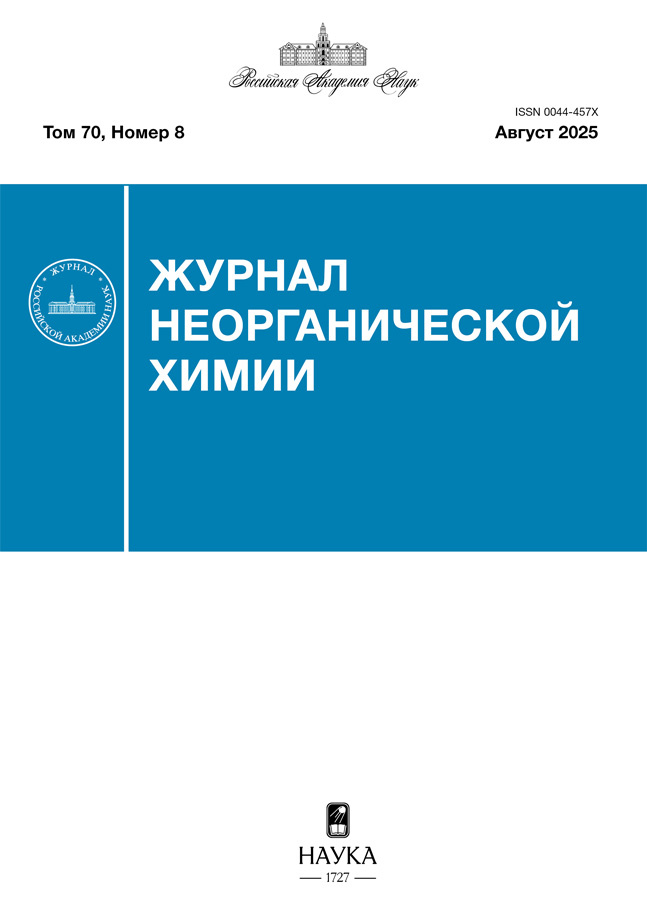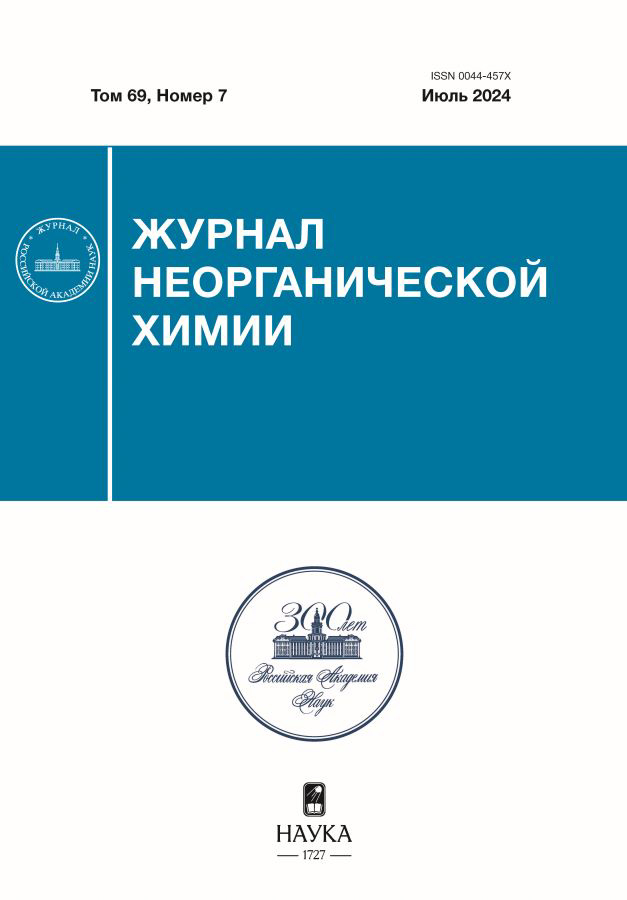Синтез, структура и магнитные свойства Mn-замещенного магнетита для магнитореологических материалов
- Авторы: Гайдук Ю.С.1, Коробко Е.В.2, Радкевич Л.В.2, Голодок Р.П.1, Усенко А.Е.1, Паньков В.В.1
-
Учреждения:
- Белорусский государственный университет
- Институт тепло- и массообмена им. А.В. Лыкова НАН Беларуси
- Выпуск: Том 69, № 7 (2024)
- Страницы: 973-980
- Раздел: СИНТЕЗ И СВОЙСТВА НЕОРГАНИЧЕСКИХ СОЕДИНЕНИЙ
- URL: https://kazanmedjournal.ru/0044-457X/article/view/666418
- DOI: https://doi.org/10.31857/S0044457X24070049
- EDN: https://elibrary.ru/XOOHVE
- ID: 666418
Цитировать
Полный текст
Аннотация
Методом соосаждения (с различными вариантами последующей термической и механической обработки осадка) синтезирован феррит железа(II)-марганца(II) состава Mn0.3Fe2.7O4. Материал исследован методами рентгенофазового анализа, инфракрасной спектроскопии, сканирующей электронной микроскопии и магнетометрии. Порошок, прошедший на заключительном этапе синтеза обжиг в аргоне при 740°С (8.0 ч) и высокоэнергетический помол (1.0 ч), является перспективным функциональным наполнителем для магнитореологических материалов благодаря высокому значению напряжения сдвига (3500 Па при 625 мТл) масляной суспензии, изготовленной на его основе, и высокой маслоемкости, обеспечивающей седиментационную стабильность суспензии.
Ключевые слова
Полный текст
Об авторах
Ю. С. Гайдук
Белорусский государственный университет
Автор, ответственный за переписку.
Email: j_hajduk@list.ru
Белоруссия, пр-т Независимости, 4, Минск, 220050
Е. В. Коробко
Институт тепло- и массообмена им. А.В. Лыкова НАН Беларуси
Email: j_hajduk@list.ru
Белоруссия, ул. Петруся Бровки, 17, Минск, 220072
Л. В. Радкевич
Институт тепло- и массообмена им. А.В. Лыкова НАН Беларуси
Email: j_hajduk@list.ru
Белоруссия, ул. Петруся Бровки, 17, Минск, 220072
Р. П. Голодок
Белорусский государственный университет
Email: j_hajduk@list.ru
Белоруссия, пр-т Независимости, 4, Минск, 220050
А. Е. Усенко
Белорусский государственный университет
Email: j_hajduk@list.ru
Белоруссия, пр-т Независимости, 4, Минск, 220050
В. В. Паньков
Белорусский государственный университет
Email: j_hajduk@list.ru
Белоруссия, пр-т Независимости, 4, Минск, 220050
Список литературы
- Беляев Е.С., Ермолаев А.И., Титов Е.Ю., Тумаков С.Ф. Магнитореологические жидкости: технологии создания и применение: монография. Нижегород. гос. техн. ун-т им. Р.Е. Алексеева. 2017. 94 с.
- Vekas L. // Adv. Sci. Technol. 2008. V. 54. № 1. P. 127. https://doi.org/10.4028/www.scientific.net/ASТ. 54.127
- Fang F.F., Choi H.J., Jhonb M.S. // Colloids Surf. A: Physicochem. Eng. Aspects. 2009. V. 351. P. 46.
- Chary T.R.G., Allaparthi M., Dusa S. еt al. // Intelligent Manufacturing and Energy Sustainability. ICIMES 2023. Smart Innovation, Systems and Technologies. Singapore: Springer, 2024. V. 372. https://doi.org/10.1007/978-981-99-6774-2_46
- Корсакова А.С., Котиков Д.А., Гайдук Ю.С., Паньков В.В. // Конденсированные среды и межфазные границы. 2020. Т. 22. № 4. С. 466. https://doi.org/10.17308/kcmf.2020.22/3076
- Гордеев Б.А., Иванов Е.Г., Охулков С.Н. и др. // Вестник машиностроения. 2023. № 6. С. 499. https://doi.org/10.36652/0042-4633-2023-102-6-499-504
- Kordonsky W. // Materials Technology. 1993. V. 8. № 11/12. P. 240.
- Ghaffari A., Hashemabadi S., Ashtiani M. // J. Intell. Mater. Syst. Struct. 2015. V. 26. № 8. P. 881.
- Костров С.А., Тихонов П.А., Музафаров А.М., Крамаренко Е.Ю. // Высокомол. соединения. Сер. А. 2021. Т. 63. С. 198. https://doi.org/10.31857/S230811202103007X
- Шульман З.П., Кордонский В.И. Магнитореологический эффект. Минск: Наука и техника, 1982. 184 с.
- Гордеев Б.А., Ермолаев А.И., Охулков С.Н. и др. //Вестник машиностроения. 2023. № 3. С. 192. https://doi.org/10.36652/0042-4633-2023-102-3-192-201
- Гареев К.Г., Лучинин В.В., Мошников В.А. // Биотехносфера. 2013. Т. 5. № 29. С. 2.
- Lu A.-H., Salabas E.L., Schutz F. // Angew. Chem. Int. Ed.2007. V. 46. № 8. P. 1222. https://doi.org/10.1002/anie.200602866
- Новопашин С.А., Серебрякова М.А., Хмель С.Я. // Теплофизика и аэромеханика.2015. Т. 22. № 4. С. 411.
- Gupta A.K., Naregalkar R.R., Vaidya V. еt al. // Nanomedicine. 2007. V. 2. № 1. P. 23. https://doi.org/10.2217/17435889.2.1.23
- Mathew D.S.,Juang R.-S. // Chem. Eng. J. 2007. V. 129. № 1–3. P. 51. https://doi.org/10.1016/j.cej.2006.11.001
- Kciuk M., Turczyn R. // J. Achievements Mater. Manufacturing. Eng. 2006. V. 18. № 1–2. P. 127.
- Kumar J.S., Paul P.S., Raghunathan G., Alex D.G. // Int. J. Mech. Mater. Eng. 2019. V. 14. № 1. P. 1. https://doi.org/10.1186/s40712-019-0109-2
- Chiriac H., Stoian G. // IEEE Transactions on Magnetics. 2009. V. 45. № 10. P. 4049. https://doi.org/10.1109/tmag.2009.2024633
- Pu H., Jiang F. // Nanotechnology. 2005. V. 16. № 9. P. 1486. https://doi.org/10.1088/0957-4484/16/9/012
- Manuel J.G. de Falco, Bombard A.J.F., Weeks E.R. //Smart Mater. Struct. 2023. V. 32. № 4. P. 045014. https://doi.org/10.1088/1361-665X/acbb47
- Вест А. // Химия твердого тела. Теория и приложения. В 2-х ч. / Пер. с англ. М.: Мир, 1988. Ч. 1. 558 с.
- Skumryev V., Stoyanov S., Zhang Y. еt al. // Nature. 2003. V. 423. № 6942. P. 850. https://doi.org/10.1038/nature01687
- Першина А.Г., Сазонов А.Э., Мильто И.В. // Бюллетень сибирской медицины. 2008. Т. 7. № 2. С. 70. https://doi.org/10.20538/1682-0363-2008-2-70-78
Дополнительные файлы
















